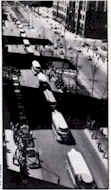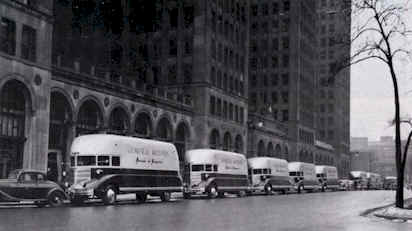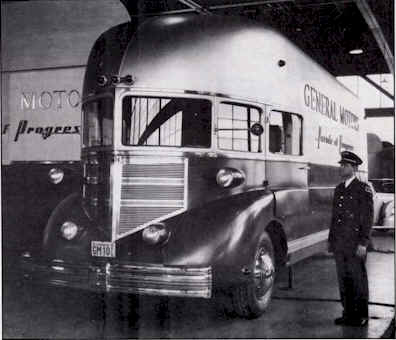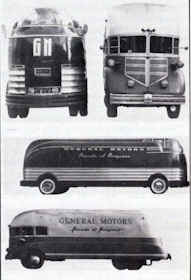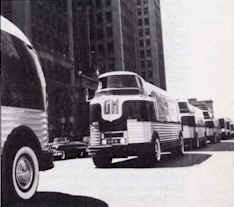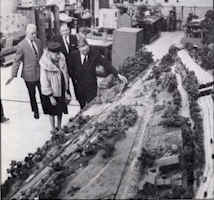
Boss Ket wanted all America – even the most remote communities – to share in GM’s latest technology. So, from 1936 through mid-1956, the Parade toured and delighted many millions of citizens.
When GM’s Parade of Progress rolled into Muskogee or Ashtabula, Yuma or Fr. Pierce, everybody turned out. Its appeal was so compelling that no one could endure staying home. In Frederieksburg, VA, for instance, enthusiasm ran so high that two-and-one-quarter times the town’s population attended.
The first Parade of Progress hit the road on Feb. 11, 1936, opening in Lakeland, FL. By Pearl Harbor, the Parade had covered well over a million miles, had visited 251 towns and small cities in the U.S., Canada, Mexico and Cuba, and had played to some 12.5 million people. There would eventually be three GM Parades of Progress, the last one taking its final curtain in mid-1956. But in abbreviated form, the Parade still lives even today (note: article was written in 1977). Called Previews of Progress, it now consists of a dozen GM station-wagon shows that travel to high schools across the country.
The man who sparked General Motor’s original 1936 Parade of Progress was none other than Charles F. Kettering. Boss Ket was GM’s resident genius and research vice president – the man behind such inventions as the first commercial electric self-starter, Ethyl gasoline, the diesel-electric locomotive, and much more.
Kettering hit on the Parade idea one day as he strolled through GM’s science and technology exhibit at the 1933 Chicago world’s Fair. The thought suddenly struck him: Why not take all this out to the people – let those who can’t see it here, see GM’s exhibit in their own hometowns?
Ket talked with GM board chairman Alfred P. Sloan, Jr. and public relations vice president Paul Garrett. Both liked the idea. Together with GM’s public relations committee, they decided that the Parade and its timing were right. Depression-weary Americans flocked to movies, shows, fairs, and any sort of entertainment that took their minds off the country’s plight.
GM reasoned that a well done, non-commercial, entertaining, educational, free road show would do wonders to help put General Motors’s message across. It would bring GM, in person, to every small city and rural community in the nation.
And so the Parade got is appropriation. The caravan itself – vehicles, personnel, exhibits, props, tents, etc. – took most of 1934 and 1935 to prepare and assemble.
Focal point of the Parade was the fleet of eight huge, red-and-white, streamlined vans. These were custom built in Fisher body’s Fleetwood plant in Detroit. All eight spanned the 223-inch truck chassis and were powered by GMC gasoline engines. Six of the streamliners formed walk-through exhibits when joined together, three by three, with canvas awnings. Another van opened up to form a stage, and the eighth carried equipment.
In addition to the eight streamliners, the original 1936 Parade included nine GMC and Chevrolet tractor-trailers. These hauled gear, tents, power generators, lamps, booths, and additional exhibits. Too, the caravan used a stretched, air-conditioned 1936 Chevy "command car" on an 185-inch wheelbase. The command car served as a mobile office and general field headquarters. Finally, the caravan brought along representative models of all six GM lines – Chevrolet, Pontiac, Oldsmobile, Buick, LaSalle, and Cadillac. These cars were traded in every 2,000 miles at local dealerships along the way.
"The show’s staff consisted of 40-50 young men, all college graduates and taken from a cross section of the country," remembers Edward A. Bracken, Jr., one of the early Parade participants and now manager of GM’s corporate projects. "There must have been at least 30 universities represented by these young men – everyone the same age bracket and, I might add, all bachelors. It was out job to drive the trucks and, on arrival at the site, change into coveralls and put up the show. We then dressed and became lecturers on the exhibits. At the conclusion of each 2-4-day visit, we’d pack up and drive to the next town."
Raymond E. Hayes, another native son of the 1936 Parade and now GM’s director of public relations field operations, adds, "The three guys I broke in with were from Harvard, Columbia, and Brown – all Eastern guys. We were all hired as lecturers, but there was an apprenticeship period. While you were apprenticing, they put you on the utility crew – we called it the futility crew – and that meant you didn’t lecture until you learned every other job and also until one of the regular lecturers dropped out. What you did – you reported from the hotel to the show at about six o’clock in the morning in coveralls, and you waxed floors, took a stick with a nail on the end of it, picked up papers – that sort of thing."
Everyone I talked to who’d been with the Parade of Progress during its 20-year life-span (I interviewed 17 people in all) told me that those days were the best of their lives. They couldn’t remember enjoying a job more. Inspired and led by J. M. (Jack) Jerpe, they formed a close-knit, congenial group that worked hard, enjoyed the travel and adventure, liked to meet people, and felt they had a genuine mission – to put GM’s best face forward. Jerpe’s personality made him part father, part friend and part boss to his boys.
The idea behind the Parade was to play not the great metropolitan U.S. cities but to keep to the smaller ones. There was absolutely no "sell" involved in any of the shows or exhibits. GM cars and appliances were placed strategically, and young men were prepared to answer questions about them – in fact Jerpe held regular quizzes on such items as car specifications, listings of auto accessories, capacities of Frigidaire refrigerators, etc., with prizes going to the "students" with the highest scores.
The Parade moved with the seasons – south in winter and north in the spring. The route was chosen a year in advance. A town would receive its first notification of a visit from Paul Garrett in New York. Garrett would send a letter to the local chamber of commerce, and a few days later, one of the three Parade advance men would drive into town. Bob Emerick, recently retired as public relations director for Pontiac, remembers those days.
"There were three of us advance men alternating towns – hopscotching along the route. We’d work with the chamber of commerce and city officials – find an empty lot to pitch the tents, make hotel reservations, the work with the newspapers and radio stations; also the schools, civic clubs, and local GM dealers. We had a short movie that we brought along to give these groups a teaser of the actual shows."
The Parade of Progress presentations themselves were totally live and used no help from movies. One full show in the main tent lasted about 45 minutes. The first conventional tents, which used an opened-out streamliner as the stage, were replaced in 1940 by an external-girder type developed at GM by Fred Huddle. The early tents seated 1,200, the later ones up to 1,500.
In January 1938, the Parade went into Mexico. Ed Bracken remembers training Mexican lecturers in Texas before heading south. "We became official guest of the Mexican government," says Bracken, "and, in fact, we opened the Pan American Highway from Laredo to Mexico City. We stayed in Mexico City for two weeks, played to huge crowds, and had a marvelous time. After that we went back north, toured the Midwest, and ended up in New York a year before the 1939-40 World’s Fair opened there. We had Christmas vacation in Miami and Key West – I remember we spent the enormous sum of $10 a day for a 3-bedroom cottage on the ocean. I spent New Year’s eve in a Key West saloon discussing baseball with Ernest Hemingway. In January 1939 we took the Parade to Havana, and this, too, was very enjoyable. It was then transferred to New York to work on the GM exhibit at the World’s Fair."
In 1940, the caravan was revamped and its original eight streamlined vans were replaced with a new set of 12, called Futurliners. The Parade’s exhibits were also updated, and the operation became bigger.
World War II broke out while the Parade was again in Texas. Two weeks after Pearl Harbor, during its visit to San Antonio, the Parade disbanded and most of the staff traded its GM uniforms for khaki or blue. The caravan vehicles were driven to Ohio, where they were warehoused for the war.
The Parade wasn’t reactivated until April 1953, when the third caravan took to the road. It remained essentially the same as the 1940 version, numbering 44 vehicles and 57 men. Fred Huddle’s Aer-O-Dome tent, with its external aluminum arches and silverized vinyl-impregnated canvas skin, was made bigger. New exhibits included jet propulsion, the atmosphere, the atom, stereo, and metal-powder forming. Many of the older exhibits were held over, of course.
The postwar Parade, though, never drew the crowds of its prewar ancestors, mostly because Americans now had nightly free shows right in their own homes. Television caused the demise of the Parade, and in 1956 GM decided to disband the caravan for good. Many of the young men who’d begun their GM careers with the Parade are still with the corporation, and several had even retired by now.
| ||||||||||||
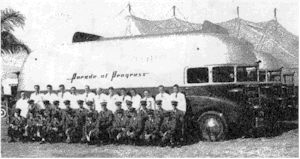 General Motors’ interest
in using the circus as a means of advertising its products has a long
history. Sometimes they displayed their vehicles in the menageries, or
arranged for circus parades to arrive at their various dealerships. In
1938, the Hagenbeck Wallace Circus had a fleet of five Chevrolet
conversion trucks that were the principal means of towing wagons from
the train to the show-grounds.
General Motors’ interest
in using the circus as a means of advertising its products has a long
history. Sometimes they displayed their vehicles in the menageries, or
arranged for circus parades to arrive at their various dealerships. In
1938, the Hagenbeck Wallace Circus had a fleet of five Chevrolet
conversion trucks that were the principal means of towing wagons from
the train to the show-grounds.In addition to these paid promotions, GM produced a complete tent show of their own on two occasions, the first being in 1936, which was organized in Detroit and moved south to Florida in a close caravan. Giving the caravan a send-off were none other than Alfred P. Sloan and Charles "Boss Ket" Kettering. No performances were given in Detroit or any of the cities en route to Florida. The plan was to get maximum publicity from the caravan itself by having it move south, visiting GM assembly plants and some of the larger dealers along the way. The fleet of unusual trucks were displayed at each site for view by employees, the public, and, of course, the press. However, the tents and midway would not be set until they reached Florida. 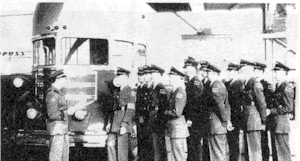 GM wanted attention even when the show passed on the highway, so
all movement was handled as a military convoy. A Cadillac command car
was in the lead and communicated with some of the trucks back in the
pack by short wave radio. An assortment of automobile models from all
GM divisions were included in the convoy. Drivers always wore uniforms
on the road, when visiting GM plants or when performing, although
white coveralls were provided for workdays when the exhibit was being
erected. GM wanted attention even when the show passed on the highway, so
all movement was handled as a military convoy. A Cadillac command car
was in the lead and communicated with some of the trucks back in the
pack by short wave radio. An assortment of automobile models from all
GM divisions were included in the convoy. Drivers always wore uniforms
on the road, when visiting GM plants or when performing, although
white coveralls were provided for workdays when the exhibit was being
erected.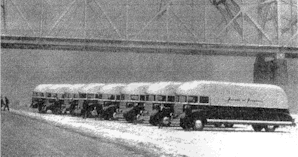 Travel was slow, partly because GM wanted everyone the convoy
passed to get a good look and partly because the streamlined trucks
were seriously underpowered by today’s standards. GM’s small truck
engines were based on the flat head Oldsmobile block and offered
displacements of only 230-257 cid. The trucks had a 4-speed
transmission with a very low first gear that the drivers called
"creeper." This was needed on many hills. Because the vacuum
power brakes were not as effective as might have been desired,
downshifting was the rule on most hills. In addition to the eight
streamliners, the fleet included conventional GM trucks, including
semis, that carried the big top, chairs, an electric light plant and
mechanics’ supplies. Travel was slow, partly because GM wanted everyone the convoy
passed to get a good look and partly because the streamlined trucks
were seriously underpowered by today’s standards. GM’s small truck
engines were based on the flat head Oldsmobile block and offered
displacements of only 230-257 cid. The trucks had a 4-speed
transmission with a very low first gear that the drivers called
"creeper." This was needed on many hills. Because the vacuum
power brakes were not as effective as might have been desired,
downshifting was the rule on most hills. In addition to the eight
streamliners, the fleet included conventional GM trucks, including
semis, that carried the big top, chairs, an electric light plant and
mechanics’ supplies.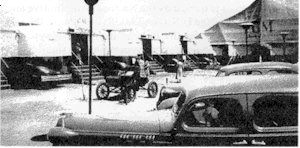 Moves were always made in daytime for publicity, so personnel were
boarded in hotels and ate in restaurants. Life in this
"circus" was easier than in most traveling shows. Drivers
were paid $100 a month; uniforms, coveralls, and hotel rooms were
provided; and the food allowance was $18.50 a week, which, in 1936,
allowed them to dine well. Like the traditional circus, the Parade of
Progress had an advance agent who traveled ahead booking lots, parking
space, hotels, and other needs. Moves were always made in daytime for publicity, so personnel were
boarded in hotels and ate in restaurants. Life in this
"circus" was easier than in most traveling shows. Drivers
were paid $100 a month; uniforms, coveralls, and hotel rooms were
provided; and the food allowance was $18.50 a week, which, in 1936,
allowed them to dine well. Like the traditional circus, the Parade of
Progress had an advance agent who traveled ahead booking lots, parking
space, hotels, and other needs.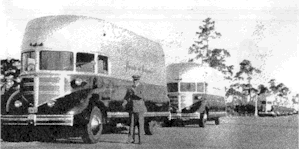 After the caravan arrived in Lakeland, FL, the tents and midway
were set up for the first time and the full performance was rehearsed.
The big top was a two-pole tent with the stage in the middle of one
long side. Seats were opposite the state and in both ends. One of the
streamliners unfolded to form the stage, and another was behind the
center section of seats, containing an enclosed movie projection booth
for films that were part of the program. Performances consisted of
juggling, magic, and scientific demonstrations tied in with product
displays. This may have been the first time that microwave cooking was
demonstrated – emcee Erie Foss cooked an egg on a handkerchief with
no protection from the radiation. After the caravan arrived in Lakeland, FL, the tents and midway
were set up for the first time and the full performance was rehearsed.
The big top was a two-pole tent with the stage in the middle of one
long side. Seats were opposite the state and in both ends. One of the
streamliners unfolded to form the stage, and another was behind the
center section of seats, containing an enclosed movie projection booth
for films that were part of the program. Performances consisted of
juggling, magic, and scientific demonstrations tied in with product
displays. This may have been the first time that microwave cooking was
demonstrated – emcee Erie Foss cooked an egg on a handkerchief with
no protection from the radiation.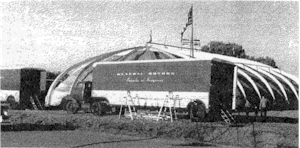 While the canvas boss and his workmen set up the tent and seats,
the drivers set up the exhibits. The truck fleet included eight
streamliners, three of which were used for a walk-through midway
display. They were parked in a parallel arrangement several feed
apart. The sides split apart horizontally so that the upper halves
joined to form a roof and the lower halves formed a floor. Side panels
carried in the truck enclosed the space, and the tree trucks thus
connected formed a continuous hall filled with exhibits. Patrons
entered the front truck and exited the rear truck. The show opened in
St. Petersburg, FL, followed by Tampa, Miami, and then went up the
East Coast, hitting most of the major cities along the way. While the canvas boss and his workmen set up the tent and seats,
the drivers set up the exhibits. The truck fleet included eight
streamliners, three of which were used for a walk-through midway
display. They were parked in a parallel arrangement several feed
apart. The sides split apart horizontally so that the upper halves
joined to form a roof and the lower halves formed a floor. Side panels
carried in the truck enclosed the space, and the tree trucks thus
connected formed a continuous hall filled with exhibits. Patrons
entered the front truck and exited the rear truck. The show opened in
St. Petersburg, FL, followed by Tampa, Miami, and then went up the
East Coast, hitting most of the major cities along the way.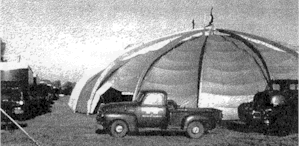 After the tour ended the equipment was stored and eventually sold,
including the streamliners. Several of these easily recognized trucks
have turned up in other service. The streamliner that formed the stage
is shown being used for a USO Motor Camp Show performance in 1941 in
the book, U.S. Military Wheeled Vehicles, where author F. W. Crismon
lists it in the 5-ton category. After the tour ended the equipment was stored and eventually sold,
including the streamliners. Several of these easily recognized trucks
have turned up in other service. The streamliner that formed the stage
is shown being used for a USO Motor Camp Show performance in 1941 in
the book, U.S. Military Wheeled Vehicles, where author F. W. Crismon
lists it in the 5-ton category.The 1954 Parade of Progress was organized on the same patter as the 1936 show, but was different in several ways. An entirely new fleet of GM trucks were used, consisting of current conventional models for the heavy loads and a new concept in streamliners for exhibits. These were evidently influenced by popular military aircraft designs and featured bubble glass cockpits for the drivers in place of conventional two-man cabs. Also, the big top was an innovative design using an exterior aluminum frame to support the canvas, and since there were no poles the interior was unobstructed. In the large cities, GM considered potential attendance and decided to forego the big top, opting instead to present a more elaborate show in large buildings. The 1954 Parade of Progress opened in Miami, FL, in a building formerly used to service big Pan-AM seaplanes. This not only accommodated the larger weekend audiences, but also allowed a huge stage that the tent could not hold. On stage was the "Motel of the Future" where the GM "Car of the Future" would roll up during performances and discharge the tourists of the future wearing apparel of the future. Unfortunately, many of there predictions did not come to pass, but the sports clothes predicted for the future were right on the money, so at least they got one part right. Most of the program was very similar to the 1936 performances, but on some dates, the indoor production was promoted as the General Motors Motorama rather than the Parade of Progress. The bubble cab trucks were all used for exhibits so the public would see them and be duly impressed by the advanced thinking at GM. Most were used for exhibits on the midway. Like some of the 1936 trucks, the upper part of the side would raise to form a canopy and the other part would drop to form a deck, with the display inside the truck. Periodically a lecturer would mount the deck and explain the display to the crowd. This type of continuous display could reach far more patrons than performances to seated audiences in the big top. All of the 1954 ultra modern trucks have not disappeared. One Futurliner is owned by the National Automotive Truck Museum of the U.S. (NATMUS) in Auburn, IN, and is being rebuilt under the direction of Don Mayton in Zeeland, MI. It is one of the survivors of a very small group of unique trucks that were never in production and will never be duplicated. Also, it may well be the last evidence of GM’s once impressive Parade of Progress. |
Source: futurliners
